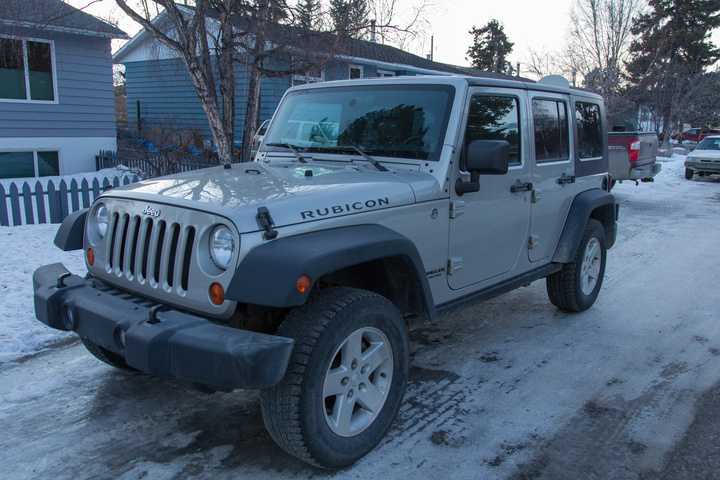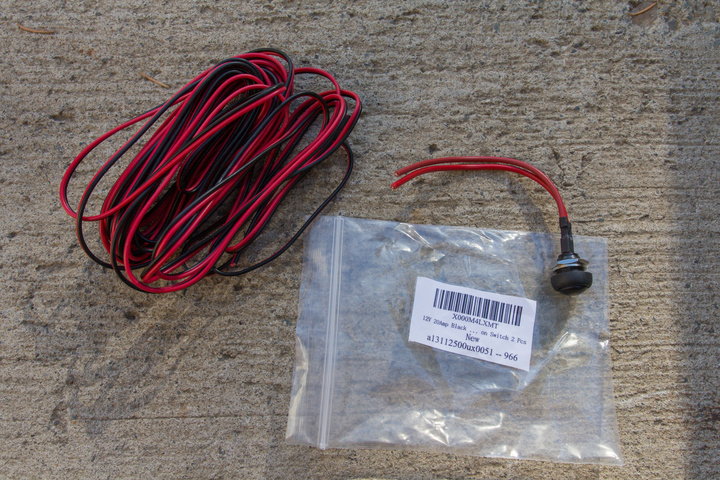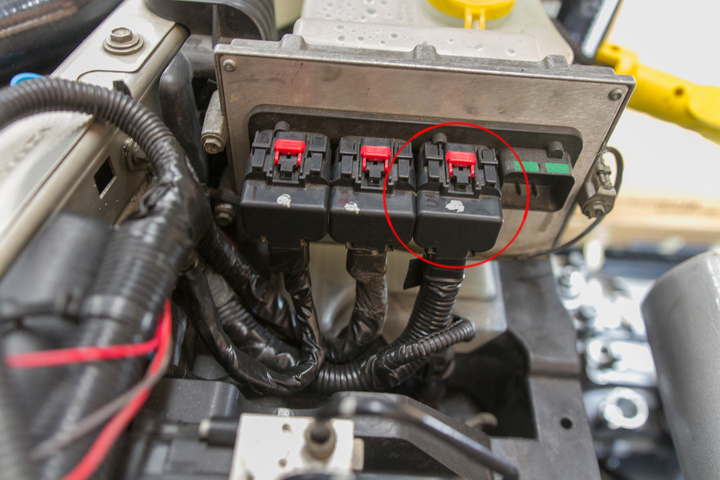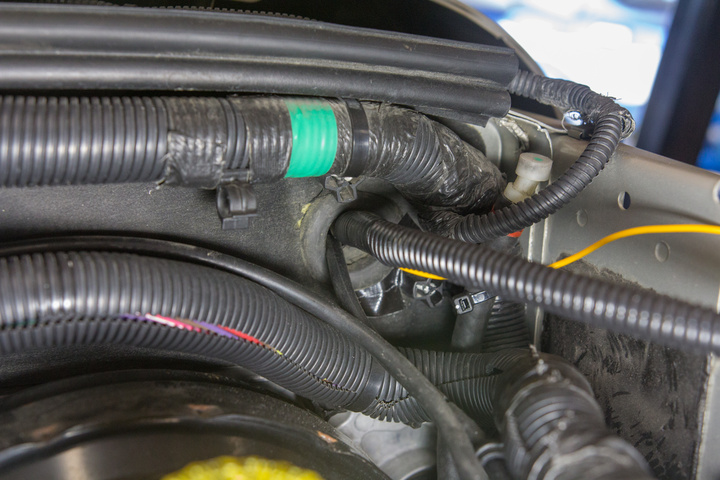
A hidden kill switch is great theft deterrence – even if someone manages to get your keys, they still won’t be able to start the Jeep. It’s an easy DIY on the cheap, total time is something like 30 – 45 minutes.
Things to buy
- A small momentary switch like this:
- Some wire like this:
Tools needed:
- A soldering iron and solder, or good quality wire crimps and crimper.
- Wire cutters / strippers.
- Electrical tape.
- A drill and drill bit to mount the switch someplace
Overview:
We’re going to use the Clutch Interlock Signal to stop the Jeep from starting unless a hidden switch is pressed. You can wire it so the switch AND the clutch must be pressed for the Jeep to start, or so that only the switch must be pressed. I personally chose to wire it so that only the switch must be pressed because I’m used to vehicles that don’t have clutch interlocks – with it in neutral, and the e-brake on, obviously.
NOTE 1: Cruise control will no longer disengage when you press the clutch after doing this modification. If you regularly disengage cruise with the clutch (I never do), maybe you shouldn’t do this mod.
NOTE 2: The Jeep ignores the clutch interlock signal when in 4LOW. Therefore this kill switch will not function when the Jeep is in 4LOW. (We could modify the wiring on that relay too, I just don’t think it’s worthwhile)
Step 1:
Locate the third connector on the Powertrain Control Module (PCM) – this is the plug closest to the engine (on the right when looking towards the front of the Jeep)
Unplug it, and pull back the covering on the wires to find the Yellow wire with Orange stripe.
Step 2a (switch and clutch):
Cut the Yellow/Orange wire, and join wires to each end – those wires will run to your switch, so that when the switch is pressed, the signal from the clutch being depressed will reach the PCM, and the Jeep will know the clutch is in, and will start.
When the switch is not pressed, the signal from the depressed clutch will not reach the PCM, and the Jeep will not start.
Step 2b (switch only):
Cut the Yellow/Orange wire, and join a wire onto the end going into the PCM plug. This wire will run all the way to your switch, along with another wire that will go to ground. When the switch is pressed, the circuit will complete to ground, and the PCM will think the clutch is depressed, and the Jeep will start.
When the switch is not pressed, the PCM will not see the clutch as being depressed, and the Jeep will not start.
Tape up the other end of the yellow/orange wire and ignore it.
Connect the second wire to ground – there are multiple options right there near the PCM on the side of the fender.
Step 3:
Run these two wires into the cabin – the best place to do this is using the factory grommet in the very top edge of the engine bay, that has the washer fluid line for the rear wiper. Pull the trim panel off the inside of the Jeep footwell next to the driver, and pull out the grommet.
Poke a small piece of strong wire through from the engine bay until you can grab it down in the footwell. Tape your wires to this and pull them through.
If you don’t have plastic “spaghetti tubing” to put the wires in, at least wrap them in tape to protect them from rubbing. Run them through the hole in the middle of the grommet so they don’t rub on the edges of the hole in the firewall.
Step 4:
Find a place to mount your hidden switch. Obviously I’m not going to show you where I put mine, because that defeats the purpose. Take your time and find a spot that works well for you.
A couple of things to think about:
• Likely you’ll be turning the key with your right hand, so you want it somewhere you can reach with your left, unless you want to be a contortionist to start the Jeep.
• Try to get it out of sight, and also not in a place that can be easily “felt”. If someone were to run their hands under the panel at the bottom of the steering wheel would they immediately find your switch?
• Do you want to put the switch somewhere you must be sitting in the drivers seat to reach? Or would you rather be able to stand outside the Jeep?
• Lots of the panels near the steering wheel flex quite a lot when pressed…. If you mounted the switch behind one of those without cutting a hole in the panel, you could just push the panel in the right place, which would flex enough to press the switch, and nobody would ever know it’s there…
• Be creative!
Wherever you choose, run your wires to that spot, drill a hole of the correct size in whatever panel needs it and mount your switch.
Connect your switch to the two wires, and make sure you completely hide all the wiring behind trim panels.
Step 5:
Test out your new hidden kill switch. You will have to hold down the switch for the duration of the time you are starting the Jeep – once it’s running you can let go.
That’s it, grab a beer!
-Dan






Hi, I have a 2014 JKUR and my PCM only has 2 plug ports. In the plug closest to the engine, I spotted the yellow wire with the orange stripe, but I’m hesitant to try it as I can’t find anywhere to confirm that wire coloring would still indicate clutch interlock in a 2014. Does chrysler keep the same wire coding even when the plug configuration changes? Thanks!
Hey TRAU,
Sorry, I have no idea if things are the same or changed in the 2014. Can you get a hold of the factory service manual?
You could strip the wire without cutting it, and then test continuity to ground with the clutch out and in – if it goes to ground when the clutch is in, it’s the right wire.
Good luck!
-Dan
I also have a ’14 JKUR and would be interested in know this. Thanks
Hi Dan,
I can confirm it is the yellow/orange wire. JKU Wrangler 2017. It is on the plug port FURTHEST from the engine…I almost confused it with a yellow/purple coloured wire on the other plug port closest to the engine.
Anyway, I just installed the kill switch as per your instructions and it is working fine. I didn’t go in through the factory grommet though. I used the location in this video as it is a bit easier for where I wanted the switch.
https://www.youtube.com/watch?v=Fjjt5_wbeQE
(there is an identical access point at the driver’s side or passenger side).
Thanks for your very useful write-up.
(Not sure if you are in still in South Africa, but the only place I’ve ever on the entire continent is Hermanus – great for whale watching from the shore!!!)
Safe travels!
Mick
Isn’t the switch and wiring inside the cab too? I haven’t looked yet, but wouldn’t it make sense to cut the wire to the switch inside the cabin than cutting it in the wiring loom and running (yet another) wire through the firewall? Just curious, before I do this tonight.
Hi Chris,
The original Clutch safe switch wiring is on the back of the clutch pedal, which you actually access from inside the engine bay.
It *might* have been possible to reach in and get it from there, but I decided against it so I could make the cut and splice where I could actually reach and do a good job.
Good luck!
-Dan
For anyone wanting to do this on a 2016, it appears that they changed it up a little bit. I needed a “normally off” switch, and it works as described.
Thanks Mike!
I spoke too soon
While I was able to get the switch to work perfectly, I could not fool the computer. No matter how I hooked it up or what gauge wire I used, the computer would throw a DTC. After clearing the code and starting the engine again, the code would reappear almost immediately. As soon as I removed the switch and clearing the code, it has not come back. I am stumped – I love having the switch but am not willing to drive around with the MIL on.
Hi Mike,
Sorry I have no idea with the 2016s. It seems like your modification has done something other than just letting the computer know the clutch is depressed.
I’d be trying to get the factory service manual if I were you.
-Dan
I used your idea and implemented on my ’03 TJ. Tapped directly into clutch switch wires. Access was pretty simple right behind the plastic panel that surrounds the lower part of steering wheel. Worked like a charm! I feel more confident about it not getting stolen now.
Thanks!
Great to hear George!!
-Dan
Love the tutorial, but I have a question. Say someone does have your key, or just jimmies the steering lock. If you’re parked on an incline, what’s stopping them from just rolling the jeep a bit and popping the clutch? Would it be a bad idea to use a locking on/off switch and wire it to the fuel pump relay instead? I’m actually asking because I’m kind of torn about which way to proceed here.
Hi Dan,
If they had the key they could push start it for sure.
Without the key the computer will never let it run.
But for me I didn’t need 100% security, I needed something of a deterrent, and something that would slow down a thief.
-Dan
Is this the same procedure for manual and automatic jeep wrangler jk 2017?